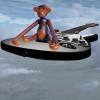
Sign in to follow this
Followers
0

Did someone ever a high altitude t/o with an empty NGX and low fuel?
By
FlyingAxx, in PMDG 737NGX | 737NGXu


By
FlyingAxx, in PMDG 737NGX | 737NGXu